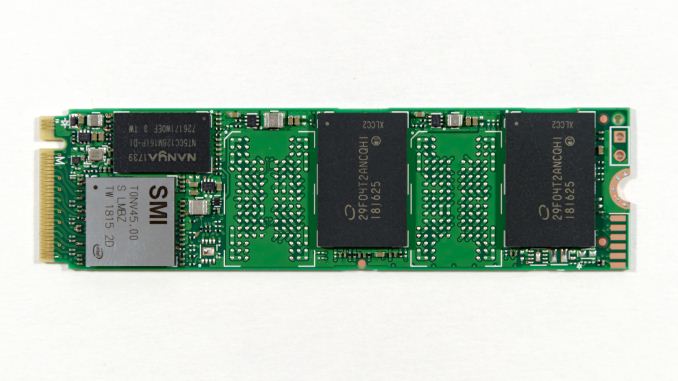The Intel SSD 660p SSD Review: QLC NAND Arrives For Consumer SSDs
by Billy Tallis on August 7, 2018 11:00 AM ESTConclusion
As the first SSD with QLC NAND to hit our testbed, the Intel SSD 660p provides much-awaited hard facts to settle the rumors and worries surrounding QLC NAND. With only a short time to review the drive we haven't had time to do much about measuring the write endurance, but our 1TB sample has been subjected to 8TB of writes and counting (out of a rated 200TB endurance) without reporting any errors and the SMART status indicates about 1% of the endurance has been used, so things are looking fine thus far.
On the performance side of things, we have confirmed that QLC NAND is slower than TLC, but the difference is not as drastic as many early predictions about QLC NAND suggested. If we didn't already know what NAND the 660p uses under the hood, Intel could pass it off as being an unusually slow TLC SSD. Even the worst-case performance isn't any worse than what we've seen with some older, smaller TLC SSDs with NAND that is much slower than the current 64-layer stuff.
The performance of the SLC cache on the Intel SSD 660p is excellent, rivaling the high-end 8-channel controllers from Silicon Motion. When the 660p isn't very full and the SLC cache is still quite large, it provides significant boosts to write performance. Read performance is usually very competitive with other low-end NVMe SSDs and well out of reach of SATA SSDs. The only exception seems to be that the 660p is not very good at suspending write operations in favor of completing a quicker read operation, so during mixed workloads or when the drive is still working on background processing to flush the SLC cache the read latency can be significantly elevated.
Even though our synthetic tests are designed to give drives a reasonable amount of idle time to flush their SLC write caches, the 660p keeps most of the data as SLC until the capacity of QLC becomes necessary. This means that when the SLC cache does eventually fill up, there's a large backlog of work to be done migrating data in to QLC blocks. We haven't yet quantified how quickly the 660p can fold the data from the SLC cache into QLC during idle times, but it clearly isn't enough to keep pace with our current test configurations. It also appears that most or all of the tests that were run after filling the drive up to 100% did not give the 660p enough idle time after the fill operation to complete its background cleanup work, so even some of the read performance measurements for the full-drive test runs suffer the consequences of filling up the SLC write cache.
In the real world, it is very rare for a consumer drive to need to accept tens or hundreds of GB of writes without interruption. Even the installation of a very large video game can mostly fit within the SLC cache of the 1TB 660p when the drive is not too full, and the steady-state write performance is pretty close to the highest rate data can be streamed into a computer over gigabit Ethernet. When copying huge amounts of data off of another SSD or sufficiently fast hard drive(s) it is possible to approach the worst-case performance our benchmarks have revealed, but those kind of jobs already last long enough that the user will take a coffee break while waiting.
Given the above caveats and the rarity with which they matter, the 660p's performance seems great for the majority of consumers who have light storage workloads. The 660p usually offers substantially better performance than SATA drives for very little extra cost and with only a small sacrifice in power efficiency. The 660p proves that QLC NAND is a viable option for general-purpose storage, and most users don't need to know or care that the drive is using QLC NAND instead of TLC NAND. The 660p still carries a bit of a price premium over what we would expect a SATA QLC SSD to cost, so it isn't the cheapest consumer SSD on the market, but it has effectively closed the price gap between mainstream SATA and entry-level NVMe drives.
Power users may not be satisfied with the limitations of the Intel SSD 660p, but for more typical users it offers a nice step up from the performance of SATA SSDs with a minimal price premium, making it an easy recommendation.












86 Comments
View All Comments